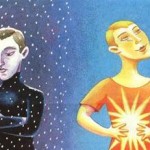Therese Borchard writes, “It’s that time of year again when the highly sensitive types among us who thrive with lots of sunlight begin to wither with the plants as the sun begins to hide.Not only do we get less vitamin D (and deficiencies have been linked to depression), but the change in sunlight affects our circadian rhythm — the body’s internal biological clock that governs certain brain activity and hormone production. In some people, the change of mood-related chemicals can cause seasonal affective disorder (SAD), also known as winter blues or seasonal depression.” Read the rest of her blog.
6 Types of Light Therapy for Seasonal Depression
7 Delicious Dinners That Help Fight Seasonal Depression
If you’re suffering with the winter blues or have full-blown seasonal affective disorder (SAS), there’s some good news: Not only is spring on the way, but there are actually certain foolds that you can eat to help ease depression and increase your energy levels. Read the Blog
Winter Blues More Than The Blahs
As many as ten to twenty percent of people in the U.S. have a mild form of depression called Seasonal Affective Disorder. Read the News
Seasonal Affective Disorder: Could You Spot the Signs
Winter is well and truly upon us. For many reasons, this means miserable weather. How does it affect your mood and what can you do about it? Read the News
Don’t Let the Sun Go Down on Me: Seasonal Affective Disorder and Depression During the Winter
There is a distinctive pallor that comes over our world at this time of the year; grey parking lots seem a lot harsher, people wandering into Starbucks this morning a tad glummer. But nothing seems tougher to deal with than a dearth of sunshine. It feels as though Mother Nature has pulled down the shades and they ain’t coming back up anytime soon.
As I scrape the shellacking of quarter-inch ice off my windshield at 6 a.m. that had built up overnight before I drive into work, I find myself pining for spring, for the sweet smell of the soil bursting back to life. But most of all, I yearn for the return of more sunny days, to the end of the great ball of light’s hibernation.
“One must maintain a little bit of summer, even in the middle of winter” wrote Henry David Thoreau. Well, that’s not always easy for those of us stuck in office buildings behind desks.
For some, the lack of sunshine actually causes a type of depression called Seasonal Affective Disorder (SAD); a syndrome of god-awful crummy symptoms that affects about 14 million Americans during the winter. Symptoms of SAD include decreased concentration, increased appetite, weight gain (whereas some other forms of depression can lead to weight loss), social withdrawal, moodiness, and fatigue.
Some people chalk these nagging symptoms up to just being down in the dumps when in reality, SAD is really a form of clinical depression. SAD is highly dependent on a person’s hormonal state, seasonal characteristics like ambient temperature, and exposure to natural light (which can influence the body’s production of melatonin). Research has linked the prevalence of SAD to higher latitudes, regions that tend to have more intense and longer winters. Just great, I thought. I live in Buffalo, New York.
But the lack of sun just doesn’t cause depression in those who might not ordinarily have it. One study found that a lack of sunshine actually may cloud memory and other thinking functions in some people who already have depression to begin with. Depressed adults from the least sunny areas were more than twice as likely to have impairments in memory and cognitive functions as those with the greatest sun exposure. The sunshine-cognition link was not seen in adults without depression, however.
Here are some ideas to start feeling better:
Shake it in the morning. For those afflicted with SAD, the time of day you work out matters. Studies show that morning exercisers report better sleep, burn up more calories throughout the day, and have lower blood pressure. Even if you don’t make it to the gym, just walking outside in the morning can really help.
Avoid the Pit Stop at The Olive Garden. When I read that white pastas, bagels and bread could lower my mood, I just switched off my computer in protest – I love pasta as much as my mom and there’s no way I can possibly give it up. But I started watching as my mood did dip after consuming a leviathan portion of rigatoni. That’s so because simple carbohydrates – think white flour stuff – give us short-lived every boost, so it’s only a matter of time before we reach for that second helping of cake spackled with butter-cream frosting. Instead, choose foods rich in protein and complex carbohydrates which release sugar into the body slowly and have a low glycemic index. Check out foods that will actually help lift your mood.
Fill Up Your Calendar. I know, I know. It’s six o’clock and you just pulled in the darkened driveway on a freeze-your-ass-off day and you just want to eat dinner and park yourself in front of the old T.V. Even on weekends. Yet research shows that people who suffer from depression report higher levels of well-being and satisfaction after positive social interactions. Feeling a sense of belonging makes us all feel better, but all the more so when you’re feeling down.
Sleepless in Seattle. Getting less slumber during these darkened days sounds like a crazy prescription for lifting one’s mood. When we feel down and the world is dark, it seems like more sleep is what’s called for to make us feel better. Not so say scientists. Instead, it’s very important to maintain a steady rhythm of sleep per night by waking up and going to bed at the same times every day – including weekends.
Light the (Artificial) Light Shine In. A light therapy regimen can significantly reduce SAD symptoms, regardless of the condition’s severity. Light therapy boxes range in brightness and type of light, so consult a physician before buying one.
Read Up. Pick up a copy of Winter Blues by Dr. Norman Rosenthal, the psychiatrist who came up with the SAD term and has studied it extensively. Check out his very informative website.
They say time heals all things. If we can hang on just long enough, the days start getting longer and the sunshine becomes more plentiful. In meanwhile, try these tips to make things more bearable and remember what the French philosopher Albert Camus once wrote,
“In the depth of winter, I finally learned that within me there lay an invincible summer.”
Is It the Winter Blues or Something More?
From the Attorney At Work blog, this piece explores the difference between just being sick and tired by winter and true depression where your low mood stays with you no matter the temperature or amount of sunlight. Read The Blog
The Remains of the Day

“Then summer fades and passes and Fall comes. We’ll smell smoke then, and feel the unexpected sharpness, a thrill of nervousness, swift elation, a sense of sadness and departure.” – Thomas Wolfe
I felt like a tortilla a few days ago; you know, flat and doughy. There’s a realization that summer’s really gone, and that the chilling zaps of winter are on the horizon.
When I wake up now, it’s dark. While driving to get my coffee, the whole murkinessof the morning is compounded by the cold rain hitting my windshield. Long gone are the summer showers that can feel so refreshing. These drops are brooding; they cover everything like oatmeal coming out of the sky.
I’m looking out the window at my regular coffee haunt – Starbucks. I like the regularity of it as the seasons change in front of me. Everybody there knows my name – sort of like Norm from Cheers. I like this easy familiarity; especially the witty banter about the work day about to begin.
I start to read a book, but throw it back in my brief case. The shortening of our days and sunlight, in my experience, seems to make depression a bit worse. The dark dank seems to reflect our inner landscape. I know winter’s coming – sort of like I felt when I knew the Bar Exam was coming. Emily Dickinson captures the sense of the melancholic days of winter:
“There’s a certain Slant of light, Winter Afternoons – That oppresses, like the weight – Of cathedral tunes. Heavenly hurt, it gives us; we can find no scar – But internal difference – Where the meanings are.”
For those of you who don’t know – but I’m sure most of you do – science has chimed in and concluded that the lack of sunshine makes some of us feel pretty crummy. It’s called Seasonal Affective Disorder (“SAD”). The reduced level of sunlight seems to cause a disruption in our biological clock which let’s you know when you should sleep or be awake. It also can lower the levels of serotonin (a known culprit in depression) and melotonin which affects our sleep patterns. Click here to see a list of symptoms compiled by The Mayo Clinic to see if you suffer from SAD.
According to expert, Norman Rosenthal, author of the book, Winter Blues, there’s an estimated fourteen million Americans who suffer from SAD and another fourteen percent of the adult U.S. population estimated to suffer from the winter blues. Dr. Rosenthal states: “Though these people are not usually affected severely enough to seek medical attention they nevertheless feel less cheerful, energetic, creative, and productive during the dark winter days than at other times of the year.”
The Mayo Clinic lists a number of remedies to treat SAD including medication, lifestyle and home remedies and alternative medicine. Things that I’ve felt helpful are as follows:
The first is the purchase and use of a bright light. It’s a box that throws off a high concentration of light. You sit in front of it for thirty minutes to a hour and let these simulated sun rays soak into your brain. For more information about how these devices work and places to buy them, check out the companies Sun Box, Inc. and Full Spectrum Solutions, Inc.
Second, I’ve found that it’s very important to schedule my vacations in the winter. My family and I go to sunny locales and bask in the sun like tortoises.
Third, get warm anyway you can. I do this in two ways. I make regular trips to the sauna at my gym. There’s nothing like sitting around with a bunch of naked guys that you don’t know –some of them are pretty hairy – to work up a rejuvenating sweat. The only thing missing are feathered head dresses and peyote. This can also be accomplished with using the old hot tub. I also change to a “warming diet” when the cold winds blow. Click here to check out a series of great articles (just click again on the “Healthy Tips” button located on left side tool bar) from Dr Elson Hass, author of the best-selling book, Staying Healthy with the Seasons.
Built by Staple Creative










